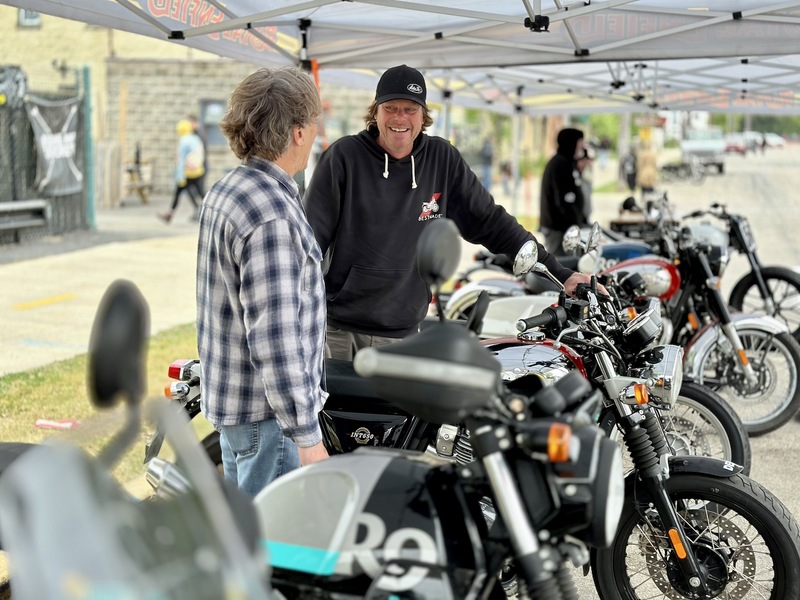For some, flying off a ramp and flipping dozens of feet into the air on a motorcycle might sound like a nightmare. For Josh Sheehan, growing up watching old Crusty Demons FMX (freestyle motocross) movies in the small Australian town of Donnybrook, it’s like a dream. And now it's his dream job, flinging himself through the air with Travis Pastrana’s Nitro Circus extreme sport stunt collective and doing the seemingly impossible – like, for instance, landing a never-before-done triple backflip on a motor bike, a feat he pulled off just earlier this summer.
Before he and the rest of the Nitro Circus crew take to the BMO Harris Bradley Center skies on Thursday night to pulverize physics, OnMilwaukee got a chance to chat with Sheehan about flipping bikes off ramps in ways that make Isaac Newton cry, having to drive like a regular person and the possibility of a quadruple backflip.
OnMilwaukee: What got you interested in the sport?
Josh Sheehan: Ever since I was a kid, I always loved adrenaline, motors, cars, wheels, motorbikes, doing tricks and jumps, and just showing off, I guess. Cars were a little tough when we were young, because you needed a license and everything, so I started off with bikes on the farm when I got some money. I started off with motocross and loved it. Doing tricks and jumps always just appealed to me. It was a bit of an adrenaline rush and allowed me to learn new things. Eventually I learned tricks, learned the backflip and then started doing shows and went from motocross racing to freestyle motocross, doing shows and extreme tricks.
OnMilwaukee: What did your parents think when you were, like, "I want to professional leap motorcycles off ramps," and stuff like that?
Sheehan: It’s funny because it was never really a goal. As a kid, I never wanted to be a professional freestyle motocross rider. I just loved doing it. Whatever time I had, I would spend on my bike riding, racing or whatever. When I was learning tricks just at home over the weekends, at one point my mom saw me watching an old movie where guys were doing backflips, and she said, "You’re never doing one of those." Psht, thought nothing of it; eventually, I got there, did a backflip and then never thought I’d learn double – and didn’t even think a triple was possible. But things progressed, and I loved it and wanted to learn as much as possible, so it took over.
OnMilwaukee: I have to ask about the triple backflip. What was going through your mind when you did that for the first time?
Sheehan: The process started in late 2013. We knew it had to be possible; we just weren’t sure how. Over a bunch of stays at Travis’ house – he changed the ramp 15 or 20 times – we eventually got something that worked jumping into an airbag. So we eventually got there, but it was such a dangerous trick that I wasn’t going to do it unless I knew it was possible and that I was going to land it.
There were a lot of nerves that day, preparing to do it, but the whole week leading up to it, I was trying to do the same thing every day: hit the jump and practice the jump to the airbag like it was the landing zone. I wanted it to be consistent. I was nervous and scared, but at the same time, I was confident. But you know, you can be confident and still know the dangers and risks that make you scared of what can happen. I was prepared, and it was a good setup; I knew what was going to happen, so I just needed to focus and do what I had been practicing.
OnMilwaukee: During practice, had you landed one officially, or was it always using that cushion airbag?
Sheehan: I kind of landed them, to the airbag; I only did one to the actual landing that I rode away from, and that was the one that I did on the day. Before Christmas, when we found the ramp that was working, we would jump to a flat airbag so I would land and then just fall over. After that ramp was working, we built a landing out of scaffolding and got a thinner airbag that was about about four or five feet thick that was draped over the landing so I could still jump and bail off and land on the airbag, or, if I landed, it was firm enough that I could ride off. I did land a bunch to the airbag, but it was still a big mental step, taking that airbag away.
OnMilwaukee: What was the kind of science or strategy behind pulling it off?
Sheehan: For a double backflip, if you get a nice steep ramp, with the power of a bike, you can get a nice flick and make the bike rotate really quick. But to get the extra time for the third backflip, you needed a much bigger jump. I was traveling at 50 miles per hour at the base of the ramp, full throttle up the 35-foot takeoff, and then you can’t just make a hundred-kilo bike suddenly start spinning – especially at that speed. Including my weight, that was a difficult one for us to work out; we had to play with a bunch of different ramp radiuses and flat spot at the end to preload the suspension a bit and have it bounce off to get it to start rotating as quick as possible. It was challenging, but we got it in the end. It took a massive jump and a lot of speed, but from a double flip to a triple flip felt ten times harder.
OnMilwaukee: So … quadruple backflip?
Sheehan: (laughs) We joked about that a lot afterwards. I’m sure it’s possible to get the rotation, but to land one? Yeah …
OnMilwaukee: I imagine your head would be all over the place after three rotations, much less four.
Sheehan: It’s funny; as you’re spinning, you can understand where you are in the rotations. In comparison to how far off the ground you are is a bit harder to keep in your mind. Travis was speaking with some gymnasts, and they were saying that for every flip added, it makes it four times harder. It felt like that with the triple flip, so to go from a triple to a quad? Four times harder? It would be an extremely tough setup. So I think that’s a little too far away. (laughs)
OnMilwaukee: Are there any tricks you’re currently working on right now?
Sheehan: A bunch of different ones. I’ve been trying to improve on backflip variations, everyday upright tricks but doing them upside down.
OnMilwaukee: Is regular driving just the worst for you? Is that just the most boring thing?
Sheehan: Yeah, if I’m just on a straight highway. Every time I have to fly away, I live two hours from the airport, so it’s two hours of just straight driving. It’s kind of boring, but at the same time, it’s also kind of peaceful, because it’s usually a mad rush – training, packing bags, getting things ready – and when I’m finally on the road, I’m finally there, and I can just relax and listen to some music.
OnMilwaukee: How have you seen the sport progress over recent years?
Sheehan: It’s been crazy progression. Years ago, when we weren’t sure was possible and Travis did the double flip, things kind of got crazy with some of the tricks. I thought it was slowing down over the last couple of years, but then a lot of body varials and quarterpipe tricks have just … things I never thought were possible were coming out.
It’s still kind of a niche sport, but it’s gone from very few people knowing anything about it to becoming a lot more worldwide and public. It’s still nothing compared to some of the major sports, but it’s getting more people involved. I don’t know how long it can go for, but it’s crazy. It keeps progressing, so I have to try to stick with it.
As much as it is a gigantic cliché to say that one has always had a passion for film, Matt Mueller has always had a passion for film. Whether it was bringing in the latest movie reviews for his first grade show-and-tell or writing film reviews for the St. Norbert College Times as a high school student, Matt is way too obsessed with movies for his own good.
When he's not writing about the latest blockbuster or talking much too glowingly about "Piranha 3D," Matt can probably be found watching literally any sport (minus cricket) or working at - get this - a local movie theater. Or watching a movie. Yeah, he's probably watching a movie.







